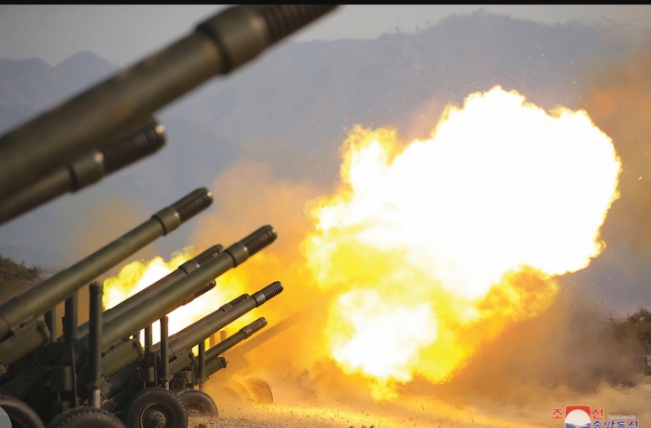N Korea fires artillery shells in ‘grave warning’ to Seoul

AlJAZEERA|PYONGYANG: North Korea has fired artillery shells off its eastern and western coasts, a day after South Korea kicked off annual defence drills aimed at boosting its ability to respond to Pyongyang’s nuclear and missile threats.
South Korea’s Joint Chiefs of Staff (JCS) said in a statement early on Wednesday that North Korea fired about 100 shells off its west coast and 150 rounds off its east coast late on Tuesday.
said the shells did not land in South Korean territorial waters but fell inside maritime buffer zones the two Koreas established under a 2018 inter-Korean agreement aimed at reducing front-line animosities.
The incident marked the second time North Korea has fired shells into the buffer zones since last Friday when it shot hundreds of shells there in its most significant direct violation of the 2018 agreement.
“We strongly urge North Korea to immediately halt its actions,” the JCS said in a statement.
“North Korea’s continued provocations are actions that undermine peace and stability of the Korean Peninsula and the international community,” it added.
Hours later, a spokesperson for the North Korean People’s Army (KPA) said that the shots were designed to send a “grave warning” to South Korea in response to its own artillery training that took place earlier on Tuesday in an eastern border region. Seoul did not immediately confirm if it had conducted any such firings.
South Korea’s Hoguk drills, which are due to end on Saturday, are the latest in a series of military exercises it has conducted in recent weeks, including joint activities with the United States and Japan.
The KPA General Staff said South Korea’s “war drill against the north is going on in a frantic manner”.
“In order to send a grave warning once again, it made sure that KPA units on the east and west fronts conducted a threatening, warning fire toward the east and west seas in the night of October 18, as a powerful military countermeasure,” it said in a statement released by state media KCNA.
“The enemies should immediately stop the reckless and inciting provocations escalating the military tension in the forefront area.”
North Korea’s artillery tests draw less outside attention than its missile launches. But its forward-deployed long-range artillery guns pose a serious security threat to South Korea’s populous metropolitan region, which is about 40 to 50km (25 to 30 miles) from the border with North Korea.
In recent weeks, North Korea has conducted a spate of weapons tests in what it calls simulations of nuclear strikes on South Korean and US targets in response to their “dangerous military drills” involving a US aircraft carrier. Pyongyang views regular military exercises between Washington and Seoul as an invasion rehearsal.
North Korea has test-launched 15 missiles since it resumed testing activities on September 25. One of them was an intermediate-range ballistic missile that flew over Japan and demonstrated a range capable of reaching the Pacific US territory of Guam and beyond.
Tokyo on Tuesday imposed additional sanctions on North Korea, targeting five organisations including Pyongyang’s Ministry of Rocket Industry and four trading firms.
“North Korea is continuing a series of provocative acts with high frequency, such as firing ballistic missiles 23 times this year,” Japanese Foreign Minister Yoshimasa Hayashi said as he announced the new measures.
Pyongyang’s actions were “violent” and “totally unacceptable”, he added.
South Korea has also imposed its first unilateral sanctions against North Korea in nearly five years, blacklisting 15 North Korean individuals and 16 institutions involved in missile development on Friday.
Some foreign experts say North Korean leader Kim Jong Un would eventually aim to use his expanded weapons arsenal to pressure the US and others to accept his country as a legitimate nuclear state and lift economic sanctions on North Korea.